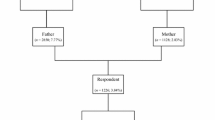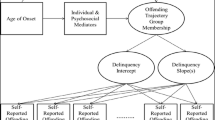Abstract
A model designed to predict early arrest is presented. Family process variables were hypothesized to be indirectly related; a childhood measure of an antisocial trait was assumed to be directly related to risk for early onset. Longitudinal data were collected for two cohorts of families living in high-crime areas of a mediumsized metropolitan area. Multiagent/multimethod definitions for both the family process and the antisocial trait concepts defined the latent constructs. Official records of police contacts were collected during the ensuing 5 years. The data for the hazard rates showed that risk for police arrest varied significantly as a function of the child's age. A continuous time regression analysis showed that most of the individual family process constructs and the antisocial trait construct were significantly related to an altered risk for police contacts. A multiple regression analysis showed a similar effect in predicting age at onset. In keeping with the hypotheses in both analyses, when all variables were entered simultaneously the contributions of the family process constructs were nonsignificant; only the contributions for the trait score and social disadvantage remained significant. The more antisocial the child, the greater the risk for early arrest.
Similar content being viewed by others
References
Achenbach, T. M., and Edelbrock, C. S. (1979).Child Behavior Checklist, National Institute of Mental Health, Bethesda, MD.
Allison, P. D. (1984).Event History Analysis: Regression for Longitudinal Event Data, Sage, Beverly Hills, CA.
Bank, L., and Patterson, G. R. (1992). Use of structural equation models in combining data from different types of assessment. In Rosen, J., and McReynolds, P. (eds.),Advances in Psychological Assessment, Vol. 8, Plenum, New York, pp. 41–74.
Bentler, P. M., and Bonnett, D. G. (1980). Significance tests and goodness of fit in the analysis of covariance structures.Psychol. Bull. 88: 588–606.
Blumstein, A., Cohen, J., Roth, J. A., and Visher, C. A. (eds.) (1986).Criminal Careers and Career Criminals, Vol. 2, National Academy Press, Washington, DC.
Capaldi, D. M., and Patterson, G. R. (1987). An approach to the problem of recruitment and retention rates for longitudinal research.Behav. Assess. 9: 169–177.
Capaldi, D. M., and Patterson, G. R. (1989).Psychometric Properties of Fourteen Latent Constructs from the Oregon Youth Study, Springer-Verlag, New York.
Capaldi, D. M., Dishion, T. J., and Patterson, G. R. (1991). Assessment of Families for the Oregon Youth Study (technical report available from Oregon Social Learning Center, 207 E. 5th Ave., No. 202, Eugene, OR 97401).
Dishion, T. J., Gardner, K., Patterson, G. R., Reid, J. B., Spyrou, S., and Thibodeaux, S. (1983). The Family Process Code: A Multidimensional System for Observing Family Interaction (technical report available from Oregon Social Learning Center, 207 E. 5th Ave., No. 202, Eugene, OR 97401).
Dishion, T. J., Patterson, G. R., Stoolmiller, M., and Skinner, M. L. (1991). Family, school, and behavioral antecedents to early adolescent involvement with antisocial peers.Dev. Psychol. 27: 172–180.
Dishion, T. J., Patterson, G. R., and Kavanagh, K. (1992). An experimental test of the coercion model: Linking measurement theory and intervention. In McCord, J., and Tremblay, R. (eds.),The Interaction of Theory and Practice: Experimental Studies of Intervention, Guilford, New York (in press).
Dunford, F., and Elliott, D. S. (1984). Identifying career offenders with self-reported data.Res. Crime Delinq. 21: 57–86.
Elliott, D. S., and Ageton, S. (1980). Reconciling race and class differences in self-reported and official estimates of delinquency.Am. Sociol. Rev. 45: 95–110.
Elliott, D. S., and Menard, S. (1988). Delinquent behavior and delinquent peers: temporal and developmental patterns; Unpublished manuscript.
Farrington, D. P. (1986). Stepping-stones to adult criminal careers. In Olweus, D., Block, J., and Yarrow, M. R. (eds.),Development of Antisocial and Prosocial Behavior, Academic Press, New York.
Farrington, D. P., and Hawkins, J. D. (1991). Predicting participation, early onset and later persistence in officially recorded offending.Crim. Behav. Ment. Health 1: 1–33.
Farrington, D. P., Gallagher, B., Morley, L., St. Ledger, R. J., and West, D. J. (1988).Cambridge Study in Delinquent Development: Long-Term Follow-up. Final report to the Home Office, Cambridge University Institute of Criminology, Cambridge, England, Nov.
Farrington, D. P., Loeber, R., Elliott, D. S., Hawkins, D. J., Kandel, D. B., Klein, M., McCord, J., Rowe, D. C., and Tremblay, R. E. (1990). Advancing knowledge about the onset of delinquency and crime. In Lahey, B. B., and Kazdin, A. E. (eds.),Advances in Clinical and Child Psychology, Vol. 13, Plenum, New York.
Forgatch, M. S. (1991). The clinical science vortex: A developing theory of antisocial behavior. In Pepler, D. J., and Rubin, K. H. (eds.),The Development and Treatment of Childhood Aggression, Lawrence Erlbaum Associates, Hillsdale, NJ.
Gendreau, P., Madden, P., and Leipciger, M. (1979). Norms and recidivism for social history and institutional experience for first incarcerates: Implications for programming.Can. J. Crim. 21: 1–26.
Glueck, S., and Glueck, E. (1950).Unraveling Juvenile Delinquency, Harvard University Press, Cambridge, MA.
Gottfredson, M. R., and Hirschi, T. (1990).A General Theory of Crime, Stanford University Press, Stanford, CA.
Hollingshead, A. B. (1975). Four-Factor Index of Social Status, Unpublished manuscript, Department of Sociology, Yale University, New Haven, CT.
Hood, R., and Sparks, R. (1970).Key Issues in Criminology, Weidenfeld and Nicolson, London.
Larzelere, R., and Patterson, G. R. (1990). Parental management: Mediators of the effect of status on early delinquency.Criminology 28: 301–323.
Laub, J. H., and Sampson, R. J. (1988). Unravelling families and delinquency: A reanalyses of the Gluecks' data.Criminology 26: 355–380.
Le Blanc, M., and Frechette, M. (1989).Male Criminal Activity from Childhood Through Youth, Springer-Verlag, New York.
Loeber, R., and Le Blanc, M. (1991). Toward a developmental criminology. In Morris, N., and Tonry, M. (eds.),Crime and Justice, Vol. 12, University of Chicago Press, Chicago.
Olweus, D. (1979). Stability of aggressive reaction patterns in males: A review.Psychol. Bull. 86: 852–875.
Patterson, G. R. (1982).A Social Learning Approach. III. Coercive Family Process, Castalia, Eugene, OR.
Patterson, G. R. (1986). Performance models for antisocial boys.Am. Psychol. 41: 432–444.
Patterson, G. R. (1992). Developmental changes in antisocial behavior. In Peters, R. D., McMahon, R. J., and Quinsey, V. L. (eds.),Aggression and Violence Throughout the Lifespan, Sage, Newbury Park, CA (in press).
Patterson, G. R., and Bank, L. (1989). Some amplifying mechanisms for pathologic processes in families. In Gunnar, M. R., and Thelen, E. (eds.),Systeins and Development: The Minnesota Symposia on Child Psychology, Vol. 22, Lawrence Erlbaum Associates, Hillsdale, NJ.
Patterson, G. R., and Dishion, T. H. (1985). Contributions of families and peers to delinquency.Criminology 23: 63–79.
Patterson, G. R., and Stouthamer-Loeber, M. (1984). The correlation of family management practices and delinquency.Child Dev. 55: 1299–1307.
Patterson, G. R., and Yoerger, K. (1992). A model for early onset of delinquent behavior. In Hodgins, S. (ed.),Crime and Mental Disorders, Sage, Newbury Park, CA (in press).
Patterson, G. R., DeBaryshe, B. D., and Ramsey, E. (1989). A developmental perspective on antisocial behavior.Am. Psychol. 44: 329–335.
Patterson, G. R., Capaldi, D., and Bank, L. (1991). An early starter model for predicting delinquency. In Pepler, D. J., and Rubin, K. H. (eds.),The Development and Treatment of Childhood Aggression, Lawrence Erlbaum Associates, Hillsdale, NJ.
Patterson, G. R., Reid, J. B., and Dishion, T. J. (1992).A Social Learning Approach. IV. Antisocial Boys, Castilia, Eugene, OR.
Reid, J. B., Bank, L., and Stoolmiller, M. (1992). The relationship of frequency and escalation in amplitude of aggression, Unpublished manuscript.
Singer, J. D., and Willett, J. B. (1991). Modeling the days of our lives: Using survival analyses when designing and analyzing longitudinal studies of duration and the timing of events.Psychol. Bull. 100: 268–290.
Stoolmiller, M. (1990).Parent Supervision, Child Unsupervised Wandering, and Child Antisocial Behavior: A Latent Growth Curve Analysis, Unpublished doctoral dissertation, University of Oregon, Eugene, Dec.
Stoolmiller, M., and Patterson, G. R. (1992). Wandering and deviant peers as determinants for frequency of arrests during early adolescence, Unpublished manuscript, Oregon Social Learning Center, Eugene.
Sullivan, J. L. (1974). Multiple indicators: Some criteria of selection. In Blalock, H. M. (ed.),Measurement in the Social Sciences, Aldine Press, Chicago.
Tolan, P. H. (1987). Implications of age of onset for delinquent risk.J. Abnorm. Child Psych. 15: 47–66.
Weis, J. G. (1986). Issues in the measurement of criminal careers. In Blumstein, A., Cohen, J., Roth, J. A., and Visher, C. A. (eds.),Criminal Careers and Career Criminals, Vol. 2, National Academy Press, Washington, DC.
Wolfgang, M. E., Figlio, R., and Sellin, T. (1972).Delinquency in a Birth Cohort, University of Chicago Press, Chicago.
Author information
Authors and Affiliations
Rights and permissions
About this article
Cite this article
Patterson, G.R., Crosby, L. & Vuchinich, S. Predicting risk for early police arrest. J Quant Criminol 8, 335–355 (1992). https://doi.org/10.1007/BF01093639
Issue Date:
DOI: https://doi.org/10.1007/BF01093639




